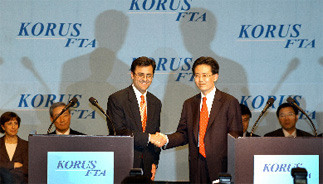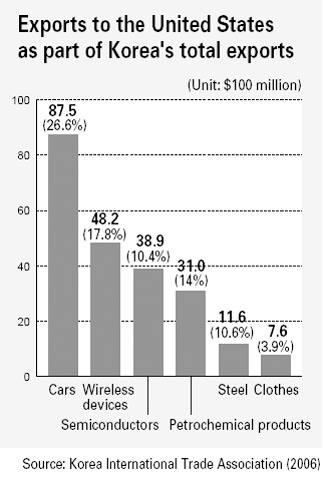It will benefit Korean exporters but the service sector will face more challenges.

Korean Trade Minister Kim Hyun-chong, right, and Deputy U.S. Trade Representative Karan Bhatia shake hands after concluding negotiations on the FTA on April 2 in Seoul. [NEWSIS]
What is an FTA? It is an international pact to bring down trade barriers so that countries covered by the agreement can sell and buy products and services to each other more easily.
Each country imposes tariffs on imported products in order to protect local producers, but the tariffs are withdrawn among countries that sign an FTA. It means consumers will be able to buy imported products at far cheaper prices. It also means prices of Korean products in foreign markets will be lowered, so that Korean companies will be able to sell more products overseas.
The deal with the United States is Korea’s fourth FTA, after free trade agreements it signed with Chile, the European Free Trade Association and Singapore. Korea’s FTA with the Association of Southeast Asia Nations (Asean) only applies to manufactured goods.
Signing an FTA has always been a hotly-debated issue, since people have conflicting interests, whether big or small.
The FTA with the United States has particularly controversial issues; critics claim that direct competition against the United States, the world’s superpower, will cause Korea more loss than gain. Would that really happen?
The United States is the world’s biggest market, whose annual imports amount to nearly $1.7 trillion won, larger than Japan, China and the Asean nations combined. It is also the biggest test bed for global market competition. The United States is the biggest importer of Korean goods and services after China; exports to the U.S. account for 13.3 percent of Korea’s total exports as of 2006. But the average market share of Korean companies in the United States has declined from 3.3 percent to 2.6 percent since the establishment of the World Trade Organization.
Korean companies cannot afford to lose ground in the United States under fierce competition with other developing countries that pour cheaper products into the American market.
Korea’s economy is largely dependent on exports, as cross-border trades account for 69.3 percent of the nation’s gross domestic product. Korea is also the world’s 11th-largest trader. So the new economic pact with the United States is expected to open a new door to expand the Korean presence in the world’s biggest consumer market.

The United States is one of the biggest providers of financial, medical, legal and telecommunication services.
Critics of the FTA claim that U.S. service companies will force out small Korean companies that are more vulnerable to competition.
But Korean companies will also be motivated to improve to survive against bigger U.S. rivals, and that will eventually strengthen the overall competitiveness of Korea’s service sector.
Some small players may be forced out of the market in the process, but it will benefit Korean consumers eventually as they are offered a broader choice and better services. In other words, no pain, no gain.
Korea relies heavily on China, Japan and the United States for international trade.
Trade with those three countries, worth $244.9 billion, accounts for nearly half of Korea’s total cross-border trade, worth $544.7 billion. Not surprisingly, many of Korea’s international trade disputes involve the three countries. From 2001 to 2005, Korea had a trade surplus of $52.8 billion and $68 billion with China and the United States, respectively.
But during the same period, Korea recorded a trade deficit of $92.6 billion with Japan.
The United States is heavily pressuring Korea to reduce its bilateral trade surplus. It is hard for Korea to refuse the demand because Korea sells an enormous amount of cars, semiconductors and steel products to that country.
The United States is the world’s biggest consumer market, meaning it has the world’s best purchasing power.
Just as disgruntled consumers can initiate a boycott against certain companies, the U.S. government can also build more trade barriers against certain countries it is unhappy with.
An FTA can forestall such a disaster for Korea, since the pact mandates both signatories open their markets all the time to each other; FTA countries cannot shut down their market capriciously.
The Korea-U.S. FTA is much bigger than all of Korea’s earlier FTAs, so its impact will inevitably be far larger.
That is why many media reports call the latest agreement “the third opening of the country,” ranked it third in significance to Korea’s first opening during the Joseon Dynasty in the 19th century and the second opening during the nation’s export boom in the 1970s.
By Jung Ha-won Staff Writer [hawon@joongang.co.kr]










with the Korea JoongAng Daily
To write comments, please log in to one of the accounts.
Standards Board Policy (0/250자)